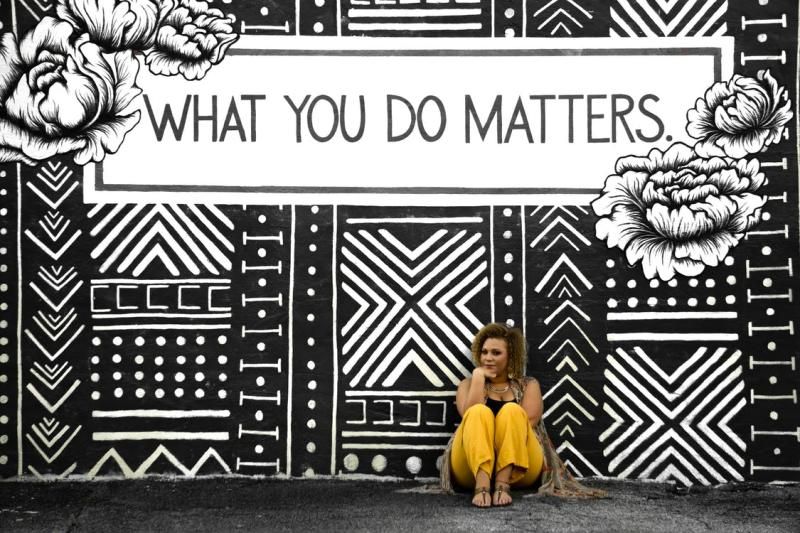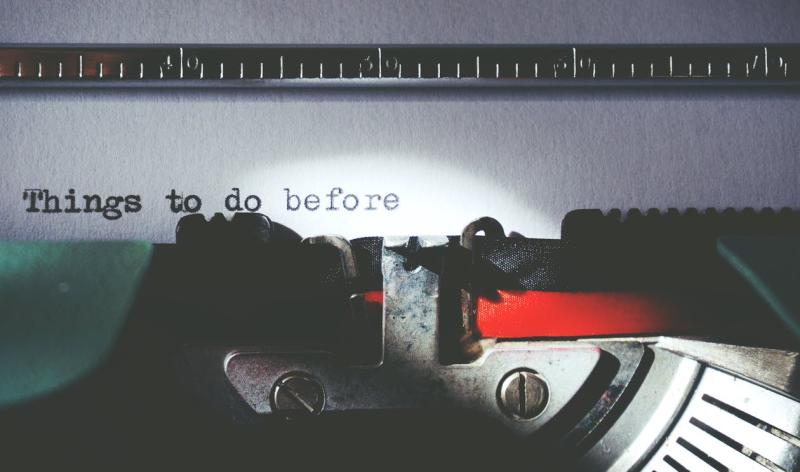Author: COP
Introduction

Woman sit leaning on a wall (Photo by Luke Webb via Pexels)
“Two of the most important things can be time and our relationships with other people” (Candy Chang).
Culture and arts can impact greatly communities at economic level, for example. This dimension is important, but more important than this one, can be how culture and arts can affect both personal and collective mindsets, values, behaviours, self and collective expression and our relationship with others. Culture and arts can contribute to the development of a community, by simply opening the door to reflect about topics that we all experience, but that sometimes we don’t know how to put into words. Might be the case of our deepest wishes, dreams, regrets and desires or might be the case of speaking about death. Anyway, by addressing the elephant in the room, it may conduct us to be more mindful about the course of action of our lives, to feel more empowered and to be in a better place/state of mind. Picking on these feelings, we feel more encouraged to take action, build (together) better places, projects or ideas for other individuals, friends, colleagues, relatives and neighbours.
What’s the activity?

Bucket list (photo by Suzy Hazelwood via Pexels)
In this quest, you’ll be equipped with some resources to change individual and collective perceptions about life and celebrate it!
You’ll get to know an art project used in public spaces for placemaking, for creating spaces that serve our communities and gain better understanding of the people we live with and places we live in, by sharing personal
aspirations in the public realm. What might seem uninteresting to ourselves, might be the right prompt to have meaningful conversations, gain perspective, wrap our head around crosscutting themes, such as love, identity, family, hope, happiness, death and have the push we needed to make our own dreams happen. By taking these small steps we might be creating the proper environment for knowing our neighbours, making friends and pouring the ingredients for social capital to bloom.
According to Candy Chang, “Our shared spaces can better reflect what matters to us, as individuals and as a community, and with more ways to share hopes, fears and stories. The people around us, can not only help us make better places. They can help us lead better lives.”
What am I going to do?
- Watch the video on social capital, to understand better this broad theory.
- Watch the TedTalk “Before I die, I want to”. Candy Chang shares the story behind this project that has been successfully replicated worldwide. If you would like watch with subtitles, select your native language on the second icon in right bottom.
- Access the official Before I Die webpage and explore it. You may read the story, read some thoughts captured from people around the globe, buy the “Before I die” book or download the toolkit to create a similar wall in your neighbourhood.
- You may choose to replicate this project or adapt it as you wish with a different prompt, according to your goals. If you choose to replicate or adapt this idea, please give credits to Before I die project or acknowledge it publicly for the inspiration.
- Choose a site where pedestrians often pass-by, may it be outdoors, for example, in a derelict building or indoors as part of an event that might taking place there (e.g., in a conference, exhibition, festival, etc.). That will make increase the chances to be a successful project and boost social capital.
- Choose a place, inform the neighbourhood what you intend to do or get permission from the relevant authorities in your city/country, get the materials and help from some volunteers eager to make this wall and let the magic happen!
- If you’d like to create some art around the gaps to fill in with chalk handwritings, using stencils, watch this video on stencil art for beginners.
- Keep the word ‘die’ in ‘Before I Die sentences’, as is referred by the author, one of the purposes of this initiative is to break the stigma revolving around death.
- From time to time, check whether there’s enough chalk in site.
- Promote it online and use the #beforeidiewall
- As it is a temporary work, don’t forget to clean it afterwards.
What will I learn?
- The importance of relationships and bonding (social capital) applied to community development;
- Creating a participatory public art installation;
- Tapping into the community member's feelings, wishes and hopes, using an 'organic' and low-resource strategy;
- Give a purpose to public spaces;
- Emotional intelligence;
- Resilience.
- Boldness;
- Curiosity;
- Sharing and change agent mindset.
What will I take home?
As western society, we tend to tiptoeing around death subject. In this exercise are showcased resources that can be exploited in your community, that will be helping you to set the stage to challenge the death taboo, normalise it, our feelings and make what unify us visible.
We tend to be ill-equipped to deal with our emotions and self-expression. By building a participatory wall in your community, you’ll be able to change the culture around death, typically avoidant. Smoothly, you’ll prepare the community to acknowledge our finitude, create more openness to cope with it, celebrate vulnerability and humanity and life in some way. Besides that, you’ll gain knowledge and experience on building a public art wall and stenciling.
Moreover, you’ll understand the power culture, arts and creative industries have to catalyze change.
Frontline Worker Toolkit
- Equip individuals with knowledge and tools to create significant participatory art initiatives;
- Reflect on the impact of public art projects to personal and community development;
- Provide individuals with tools to know better their neighbourhood;
Top tips:
This is an initiative you can teach or make use with several audiences (children, youngsters, adults or seniors), because all generations will relate to it. Is entertaining, is meaningful and doesn’t require much effort from who is preparing and the pedestrians that will write some thoughts down.
If you are planning to use these ideas with children, please replace the initial videos for some more appropriate for their age. For instance, you may replace the projection of “social capital theory” and “Before I die Ted Talk” videos for an example of bucket list for children, to inspire them about the goal of this exercise.
You may inquiry adults what whether they know what social capital is and if yes, how does it contribute to community development by providing real examples, before rushing into the Social Capital video.
As you’ll be illustrating this exercise to cultural mediators and other professionals, you may want dedicate some time exploring the experiences countries and communities that have already implemented this activity. For this purpose, please visit the tab “walls” on the “Before I die” website or search on Instagram for the tag #beforeidiewall.
To finish off the introductory part, before moving to “hands-on part”, you may take some time to speak about art or cultural projects related to mourning, grief and bereavement or asking your audience to share what’s on their bucket list or reflect on “Before I die” initiative effects at personal and community level. This discussion may be feed with data from the scientific article “Community Views on ‘What I want before I die’”
Community Views on “What I need ‘Before I die’”
https://www.ncbi.nlm.nih.gov/pmc/articles/PMC6315805/

 English (EN)
English (EN)  Türkçe (Türkiye)
Türkçe (Türkiye)  Ελληνικά
Ελληνικά  Svenska (Sverige)
Svenska (Sverige)  Português (Portugal)
Português (Portugal) 
